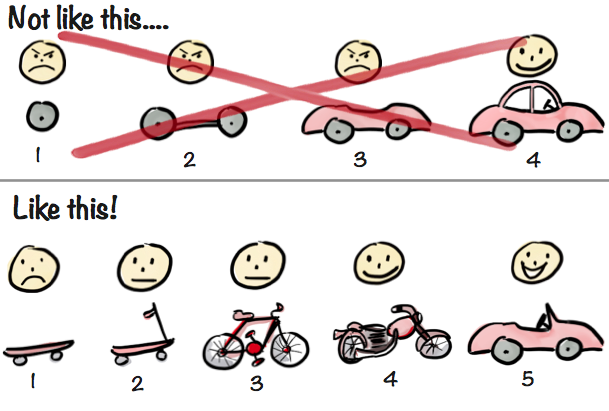When Yes means NO...
Don’t get me wrong#

I’m not talking about the conversation with your lady, your SO or your GF, this is about having productive conversations with your product owners.
As a developer, saying “YES” to a particular request is often seen as a sign of agreement. It’s a simple and straightforward response that is often interpreted as a green light to move forward. When you say “YES” you’re effectively closing the door on further discussion. All parties assume they are on the same page, and there’s no need to revisit the issue. In a sense, saying “NO” can actually open up a productive conversation.
However, sometimes saying “NO” can be the better choice, it doesn’t have to be the end of the discussion. It can simply mean that you need more information or time to consider the request. When you follow up with an explanation, you can clarify your concerns and provide an opportunity for the other party to address them.


For example, let’s say a client requests a new feature for a software project you’re working on. If you say “yes,” the client may assume that the feature will be implemented without any further discussion, or their requirement is clear enough for every party to understand. However, if you say “no” and explain that the feature would require significant resources and could delay the project timeline, the client may be able to suggest or even open to a suggestion with a more feasible alternative.
Additionally, saying “NO” can help you avoid over-committing. As a developer, you likely have a long list of tasks and deadlines to manage. If you say “YES” to every request that comes your way, you may find yourself stretched too thin. Saying “NO” can help you prioritize and manage your workload more effectively.
Of course, there are times when saying “yes” is the better choice. If a request aligns with your goals and values, you have weighed the pros and cons, and you have the resources to execute it effectively, then saying “yes” can be a great opportunity. However, it’s important to weigh the pros and cons before making a commitment and it usually takes more time.
Saying “no”doesn’t mean you are being negative or uncooperative. Instead, it means you are being thoughtful and strategic about your responses. By providing clear explanations and being open to further discussion, you can turn a “no” into a productive conversation that benefits everyone involved.
“NO” hard feelings#
How to soften the “negative” response and keep the door open
- Saying NO doesn’t have to hurt anyone’s feelings
- Provide context right after saying no
- Provide solutions, alternatives you can think of
- Invite alternative viewpoints and ideas
Down to the worst#
- There might also be a power dynamic in place, where one person feels they are either at a disadvantage or they are not free to disagree.
- There might also be a strength advantage/disadvantage around the common language of discussion, wherein one person has notably stronger/weaker language skills in the meeting language.
- How we react to this can also determine the quality of our discussion and the potential for misunderstanding
- Communication is a two-way street and we know we are communicating in a multi-cultural environment and we are often communicating in our 2nd or 3rd language.
Just Speaking the same language#
Different languages are not just about verbal communication, but also about different cultures:
-
To many western people, for example, saying NO usually means we are done, just stop talking about this topic. But to western people, it means we’re going to the negotiation phase. Therefore, within a worldwide company, this awkwardness probably happened here and there without a proper preset culture
-
Communication styles vary from person to person and from culture. For some people, “no” means “not possible”. To that person, “not possible” means that there is no need to discuss further and any more questions might aggravate the situation or the relationship and might be seen as disrespectful by ignoring the answer that was given.
-
To someone from a negotiating culture, NO just means we have not yet reached an agreement. To expert negotiators, NO is just an opening gambit; a place to start the discussion.
Should I say YES or NO, though?#
As a large organization, creating a specific culture across the company is always a top strategy to solve the problems. In the end, the goal is to encourage people speaking the same “language” and prevent unexpected reactions. However, it is not an easy task:
- Different nature of each department is already bubbling up the challenges.
-
Not all people knowing other colleagues working procedure, a waterfall procedure are often the first thought that come to mind because it’s so simple:
- Pre-sale team introduce to our beloved customers about launching a new product
- The product owner is working closely with the designer to produce the mockup
- The business analyst writing criteria for the smaller part of the product
- The tech teams split up their work and start working on separated tasks
- Technical architecture review all the code changes and announcing testing process
- Every parts of the puzzle put into production
- We starting to sale the new product
In reality it not just that simple, meetings, requirement changes, human resource changes, deadline changes, mockup changes happen every single day.
To address those challenges, we have a range of software development processes: Spiral model, Agile or something you’re naming it, there are Scrum, Extreme Processing, and other variations. If you’re new and just start reading the books, it’s not making senses that “your first release is not something look like your final product”, your normal thinking process (like waterfall) is not in the result leading to more concern questions, with uneasy feelings.

Yet, every big company as well as startups are not just following but also worshipping them.
Why is that?
We are not going to dig deeper into each of those processes, nor its pros and cons, but in the end, all those meetings, all those training, leading to a situation of everyone sitting in the same room, in different roles and having sort of an agreement.
The aim is to prevent misunderstandings caused by language differences.
In that room, Saying NO or YES usually needs to follow up with clarifications, questions, also rephrasing to provide a better meeting notes and agreements.
Let’s talk about meeting notes sometimes later
My Thought#
I’ve been reading the book No Rules Rules: Netflix and the Culture of Reinvention, watching Chinese kung-fu movies where it is common for characters to use the phrase “fight poison with poison” (kill fire with fire).
These have led me to contemplate that something that appears negative can potentially have a positive outcome.
What do you think?
Created: 2023-09-07